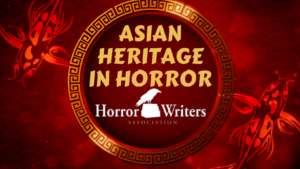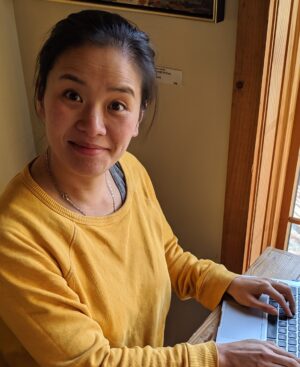
What inspired you to start writing?
I started to write fiction in 2018. I had moved to a small town. My first drafts of the Nanowrimo novel experiment were cathartic and healing. I wrote my maternal grandmother back to life, and together we got through a hard part of life, a toxic work environment, and becoming a new mother. In 2022, I took an inspiring online writing class called The Art of Fiery Prose with Giulietta Nardone. One of the assignments was submitting short stories to online journals. And I did! And mags published things!
What draws you to the horror genre?
The range of topics, writing styles, interesting character personalities, and surprises in the stories. There is something for everyone, every phase of life, and every mood. The ability to share the fresh and raw aspects of life attracts me to writing and reading in this genre. Horror blends easily with other types and genres.
Do you include Asian and/or Pacific Islander characters and themes in your writing with purpose, and if so, what do you want to portray?
I love history, discovering facts, and empowering those with knowledge. Reading an essay about U.S. Chinatown massacres in Howard Zinn’s A People’s History of the United States changed my life. It showed me the power of history to change narratives and perceptions. I was always finding my way into writing. First, I went the way of lawyering and then data science as the channel for stories. I pour a lot of myself into writing, so Asian and Asian American characters and cultures are the centerpieces of the story. Recently, I have published or written stories with themes related to anti-capitalism, colonialism, corporate horror, feminist body horror, and historical fantasies.
What has writing horror taught you about the world and yourself?
Pain and suffering are universal. The world is made up of villains and protagonists. Strong stories sympathize with both sides. In real life, this idea applies to seeing people as their emotions and wounds. Everyone has a backstory.
How have you seen the horror genre change over the years? How do you think it will continue to evolve?
I started reading R.L. Stine’s Fear Street series in middle school. I loved horror but didn’t find the characters relatable to me or my cultural heritage. Fast forward to 2023, I attended my first Stokercon, and was amazed to meet the Asian Pacific Islander editors and contributors to the Black Cranes: Tales of Unquiet Women and Tortured Willows. All horror writers I would have loved to read as a young adult (and adult). As a reader, I love the growing inclusiveness of this space. Horror stories start conversations and speak hard truths. As a result of more representation in horror, it seems to have grown the genre’s popularity.
How do you feel the Asian and/or Pacific Islander communities have been represented thus far in the genre and what hopes do you have for representation in the genre going forward?
The gaps in Asian-Pacific Islander American representation are slowly closing. I grew up outside of Chicago, one of the few Asian families in my suburb. If it wasn’t for my parent’s weekly video cassette tape rentals of Hong Kong dramas, I wouldn’t have developed a sense of belonging. For a long time, Asians in American media were limited to background roles – delivery boy, restaurant worker, a backdrop for the white hero, or oversexualized and submissive women. Hence, my excitement for the increasing number of Asian and Asian Pacific Islander American authentic representations.
Who are some of your favorite Asian and/or Pacific Islander characters in horror?
The lore of vengeful female ghosts, every culture has them. These characters are heavily tied to place and historical context. Cassandra Khaw’s jilted Japanese bride haunting an abandoned mansion in Nothing But Blackened Teeth, Ai Jiang’s town of living ghosts in Linghun, and Hungry Ghosts in Bound Feet by Kelsea Yu. Reading a historical female perspective is my catnip. Fairest Flesh by K.P. Kulski is a gothic horror fairytale. K.P. Kulski’s House of Pungsu is my next read about a Joseon-era palace princess stuck inside a palace. The Shanghainese gangster heiress in These Violent Delights by Chloe Gong shows living in the ruthlessness of colonialism in the 1920s. I am excited about Angela Yuriko Smith’s Inujini, an upcoming novel about three indigenous Ryukyuan girls in WWII Okinawa Japan.
Can you recommend some Asian and/or Pacific Islander horror authors for our readers to check out?
Black Cranes and Tortured Willows anthologies are good places to start. Adding to the books I mentioned above: The Fervor by Alma Katsu is a blend of history, ghost story, and life in a Japanese Internment camp. It’s a fast-moving multiple POV. Mona Awad’s Bunny changed my reading world, so gravitating toward the surreal is Every Version of You by Grace Chan.
What is your best advice for horror authors today?
Writing is a long game. I am at the start of my writing journey, so my objective is endurance–stay in the race/ring/on the wall/[other sports analogy] for as long as possible. Stay hydrated and motivated. Also, this means creating a pipeline for short and long-story submissions. I start with paying markets and when I start to feel discouraged, I’ll submit stories to non-paying customers to increase my chances of publishing a story. I come from a privileged position to give this advice since writing is not my main source of income. Find your purpose in publishing. Also, I self-published a short story collection with previously published stories, so I can hand it out at upcoming in-person events.
And to the Asian and/or Pacific Islander writers out there who are just getting started, what advice would you give them?
Write as if your parents aren’t reading. Just kidding! Write for yourself. Find out what your shadow wants to say.
 Pauline Chow writes speculative fiction to explore alternative histories and possible futures. Her short-story collection Goodnight Nobody and Other Haunted Bedtime Stories will be available in paperback in May 2024. The ebook and audio are coming out at the end of this year. Updates and links here.
Pauline Chow writes speculative fiction to explore alternative histories and possible futures. Her short-story collection Goodnight Nobody and Other Haunted Bedtime Stories will be available in paperback in May 2024. The ebook and audio are coming out at the end of this year. Updates and links here.
She lives in the woods and is planning her next trip to a historical (hopefully haunted) hotel. Not your average techie, she used to sue slumlords and advocate for affordable housing in Southern California. But her love of snow brought her back to the Midwest. Her words appear in Cosmic Horror Monthly, Apocalypse Confidential, Duck Duck Mongoose, 101 words, and more forthcoming. In addition to short stories, she is querying an adult psychological horror, Year of the Swine, and a Young Adult Gothic Hong Kong novel, Four Days from the Full Moon. Find her at www.paulinechowstories.com, Substack: paulinechow.substack.com, and X /@itspaulinechow


Thank you for the shout out for Inujini! I love the books you suggest and found a few I haven’t read yet! “Write as if your parents aren’t reading.” is now some of my favorite writer advice.
Instead of bedtime stories, I remembered I loved to stay on my bed to listen horror’s story. As a young reader at my school, I couldn’t find any book that being recommended by teacher or Adult. Times goes by, I am wondering is it still happened?
This is exactly why as many